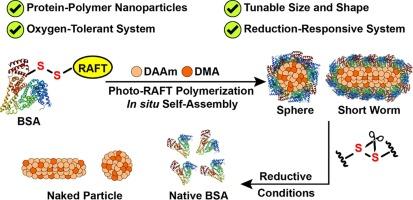Oxygen-tolerant photo-RAFT enables in-situ synthesis of protein-based nanoparticles
IF 5.8
2区 化学
Q1 POLYMER SCIENCE
引用次数: 0
Abstract
Protein-polymer conjugates are an important class of hybrid biomaterials with significant potential for biomedical applications. This study presents an innovative method for synthesizing and self-assembling these conjugates into nanoparticles using an oxygen-tolerant photoinitiated reversible addition-fragmentation chain transfer polymerization-induced self-assembly (RAFT-PISA) technique. By employing eosin Y/triethanolamine (EY/TEOA) as a photocatalyst system, oxygen inhibition is successfully overcome. As a model, a disulfide-containing bovine serum albumin (BSA) macro-RAFT agent is synthesized and used to control the copolymerization of N,N-dimethyl acrylamide (DMA) and diacetone acrylamide (DAAm). The resulting amphiphilic BSA-P(DMA-co-DAAm) conjugates self-assemble into well-defined spherical micelles. The study meticulously explores how various factors–such as the degree of polymerization (DP), DMA content, solid content, and grafting density (number of polymer chains per protein) affect the size and morphology of the nanoparticles. Finally, the introduction of reduction-sensitive disulfide linkages between proteins and synthetic polymers imparts degradability under biologically relevant redox conditions, making these conjugates promising candidates for drug delivery applications. This study offers a versatile and efficient strategy for the synthesis and self-assembly of protein-polymer conjugates into nanoparticles with potential applications in biomedicine.

耐氧光-RAFT 实现了基于蛋白质的纳米粒子的原位合成
蛋白质-聚合物共轭物是一类重要的混合生物材料,具有巨大的生物医学应用潜力。本研究采用耐氧光引发的可逆加成-断裂链转移聚合诱导自组装(RAFT-PISA)技术,提出了一种将这些共轭物合成并自组装成纳米颗粒的创新方法。通过使用曙红 Y/三乙醇胺(EY/TEOA)作为光催化剂体系,成功克服了氧抑制。作为一个模型,合成了一种含二硫化物的牛血清白蛋白(BSA)大 RAFT 剂,并用于控制 N,N-二甲基丙烯酰胺(DMA)和双丙酮丙烯酰胺(DAAm)的共聚。由此产生的两亲性 BSA-P(DMA-co-DAAm)共轭物可自组装成定义明确的球形胶束。研究细致地探讨了聚合度 (DP)、DMA 含量、固体含量和接枝密度(每种蛋白质的聚合物链数量)等各种因素如何影响纳米颗粒的大小和形态。最后,在蛋白质和合成聚合物之间引入对还原敏感的二硫键,可在生物相关的氧化还原条件下降解,使这些共轭物成为药物输送应用的理想候选材料。这项研究为将蛋白质-聚合物共轭物合成和自组装成纳米颗粒提供了一种多功能、高效的策略,有望应用于生物医学领域。
本文章由计算机程序翻译,如有差异,请以英文原文为准。
求助全文
约1分钟内获得全文
求助全文
来源期刊

European Polymer Journal
化学-高分子科学
CiteScore
9.90
自引率
10.00%
发文量
691
审稿时长
23 days
期刊介绍:
European Polymer Journal is dedicated to publishing work on fundamental and applied polymer chemistry and macromolecular materials. The journal covers all aspects of polymer synthesis, including polymerization mechanisms and chemical functional transformations, with a focus on novel polymers and the relationships between molecular structure and polymer properties. In addition, we welcome submissions on bio-based or renewable polymers, stimuli-responsive systems and polymer bio-hybrids. European Polymer Journal also publishes research on the biomedical application of polymers, including drug delivery and regenerative medicine. The main scope is covered but not limited to the following core research areas:
Polymer synthesis and functionalization
• Novel synthetic routes for polymerization, functional modification, controlled/living polymerization and precision polymers.
Stimuli-responsive polymers
• Including shape memory and self-healing polymers.
Supramolecular polymers and self-assembly
• Molecular recognition and higher order polymer structures.
Renewable and sustainable polymers
• Bio-based, biodegradable and anti-microbial polymers and polymeric bio-nanocomposites.
Polymers at interfaces and surfaces
• Chemistry and engineering of surfaces with biological relevance, including patterning, antifouling polymers and polymers for membrane applications.
Biomedical applications and nanomedicine
• Polymers for regenerative medicine, drug delivery molecular release and gene therapy
The scope of European Polymer Journal no longer includes Polymer Physics.
 求助内容:
求助内容: 应助结果提醒方式:
应助结果提醒方式:


